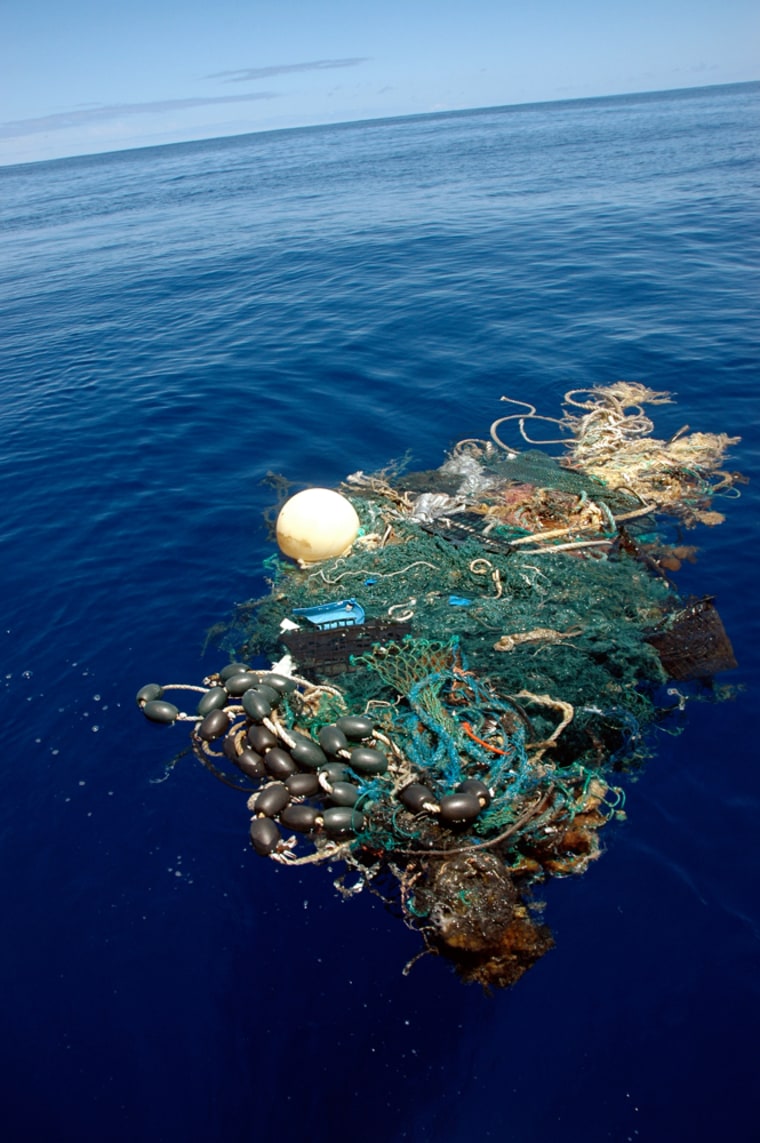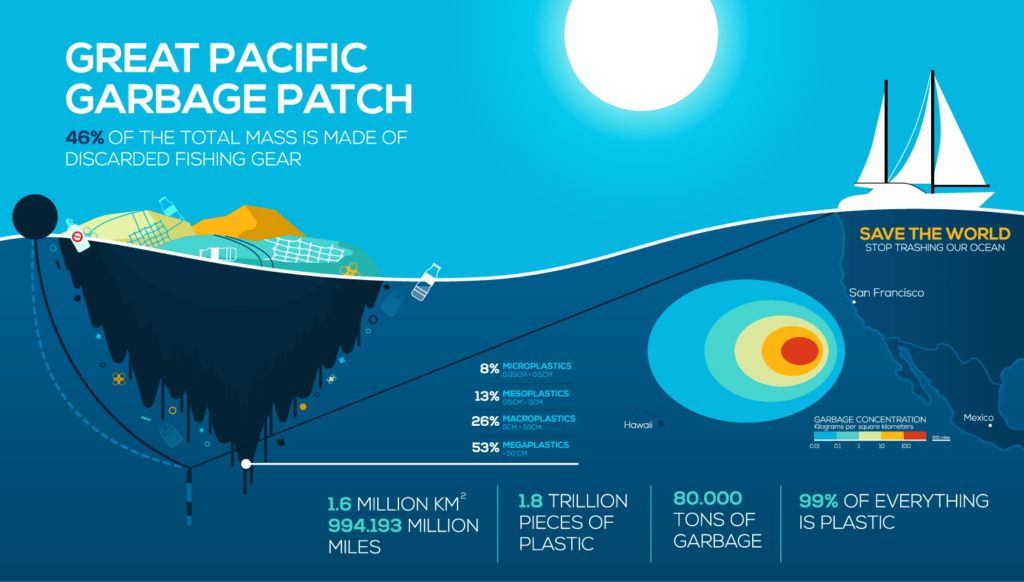Ocean Garbage Patch
They are formed by rotating ocean currents called gyres. Garbage patches are large areas of the ocean where litter fishing gear and other debris - known as marine debris - collects.
 Growth Of Ocean Garbage Patch Alarms Experts
Growth Of Ocean Garbage Patch Alarms Experts
The garbage patch is a popular name for concentrations of marine debris in the North Pacific Ocean.

Ocean garbage patch. The Ocean Cleanup is developing a passive cleanup method which uses the natural oceanic forces to rapidly and cost-effectively clean up the plastic already in the oceans. First of all because they are tiny. It was formed as a result of massive plastic pollution in our oceans.
Ocean Garbage Patch is dedicated to finding ways of removing plastics from the Worlds oceans. According to the Marine Debris Program within the National Oceanic and Atmospheric Administration NOAA the earth has five gyres in its oceans. Our research includes determining the scope of the problem.
Everything about Earth is rather marvelous how it functions how its the. These natural gathering points appear where rotating currents winds and other ocean features converge to accumulate marine debris as well as plankton seaweed and other sea life. In the process they found that they can predict which garbage patch will receive a piece of.
Two in the Atlantic two in the Pacific and one in the Indian Ocean. The estimates of the size of an ocean plastic garbage patch varies from 700000 square km to 15000000 Sq km. It is estimated that 115 to 241 million tonnes of plastic are entering the ocean each year from rivers.
There are many garbage patches and by that we mean that trash congregates to various degrees in numerous parts of the Pacific and the rest of the ocean. It is located halfway between Hawaii and California. The Great Pacific Garbage Patch GPGP is the largest of the five offshore plastic accumulation zones in the worlds oceans.
The Great Pacific Garbage Patch is a massive dump of floating garbage in the Pacific Ocean. But theyre not areas where you can easily go through and skim trash off the surface. We contribute to it everyday by littering and using un-biodegrada.
With a full fleet of cleanup systems in the Great Pacific Garbage Patch we aim to clean up 50 of its plastic every five years. The five biggest ocean garbage patches are located across the globe found in the Pacific Atlantic and Indian Oceans. In some parts the garbage is tightly packed to form islands of trash and in some other parts less so.
The Great Pacific Garbage Patch is a massive vortex of plastic litter in the north central Pacific Ocean. You can think of them as big whirlpools that pull objects in. Marine debris is litter that ends up in oceans seas and other large bodies of water.
The words garbage patch accurately describes what it is because these are patches of ocean that contain our garbage. The following videos show what a minute part of an ocean garbage patch looks like. The Great Pacific Garbage Patch also known as the Pacific trash vortex spans waters from the West Coast of North America to Japan.
While the North Pacific patch or as it is more widely known the Great Pacific garbage patch is the most discussed explored and evaluated the other four patches also contribute to global pollution on a major scale. The Great Pacific Garbage Patch is a collection of marine debris in the North Pacific Ocean. According to a new study led by Mirjam van der Mheen a doctoral candidate at the University of Western Australia the Indian Oceans unique geography ocean currents and atmospheric conditions actually appear to be preventing waste from piling up in a garbage patch.
Home Ocean Facts What is the Great Pacific Garbage Patch. The Great Pacific Garbage Patch is located in the North Pacific gyre between California and Hawaii. Garbage patchWorlds largest collection of ocean garbage is twice the size of Texas The Great Pacific Garbage Patch a collection of plastic floating.
While Great Pacific Garbage Patch is a term often used by the media it does not paint an accurate picture of the marine debris problem in the North Pacific ocean. Each of our ideas are thoroughly tested in the lab or in the field to ensure efficacy. Pinpointing where all the plastic goes says van der Mheen is a huge challenge.
By using models of ocean currents researchers have calculated the boundaries of each section of the ocean which can extend beyond the traditionally defined borders.
 Monterey Bay Littered With Tiny Plastic Pieces New Study Finds
Monterey Bay Littered With Tiny Plastic Pieces New Study Finds
 What Is The Pacific Garbage Gyre Population Education
What Is The Pacific Garbage Gyre Population Education
 Ocean Cleanup Makes History By Successfully Collecting First Plastic From Great Pacific Garbage Patch
Ocean Cleanup Makes History By Successfully Collecting First Plastic From Great Pacific Garbage Patch
 Don T Call It A Garbage Patch The Truth About Cleaning Up Ocean Plastics Huffpost
Don T Call It A Garbage Patch The Truth About Cleaning Up Ocean Plastics Huffpost
 The Pacific Ocean Garbage Patch Is A Phenomenon That Occurs Due To Ocean Currents Swirling In T Great Pacific Garbage Patch Ocean Garbage Patch Ocean Pollution
The Pacific Ocean Garbage Patch Is A Phenomenon That Occurs Due To Ocean Currents Swirling In T Great Pacific Garbage Patch Ocean Garbage Patch Ocean Pollution
 Apakah Sampah Di Laut Bisa Hilang Kafe Kepo
Apakah Sampah Di Laut Bisa Hilang Kafe Kepo
 The Ocean Cleanup Successfully Catches Plastic In Great Pacific Garbage Patch Petrochemicals Products Services Refining Petrochemicals Middle East
The Ocean Cleanup Successfully Catches Plastic In Great Pacific Garbage Patch Petrochemicals Products Services Refining Petrochemicals Middle East
 300 Mile Swim Through The Great Pacific Garbage Patch Will Collect Data On Plastic Pollution
300 Mile Swim Through The Great Pacific Garbage Patch Will Collect Data On Plastic Pollution
 Plastic Ocean The Great Pacific Garbage Patch Biodiversity Reset Org
Plastic Ocean The Great Pacific Garbage Patch Biodiversity Reset Org
 Great Pacific Garbage Patch Threat To Marine Life Youtube
Great Pacific Garbage Patch Threat To Marine Life Youtube
 The Great Pacific Garbage Patch Taking Out The Trash
The Great Pacific Garbage Patch Taking Out The Trash
 Redrawing The Map Could Reveal Ocean Garbage Patch Culprits
Redrawing The Map Could Reveal Ocean Garbage Patch Culprits
 Great Pacific Garbage Patch National Geographic Society
Great Pacific Garbage Patch National Geographic Society
 The Great Pacific Garbage Patch Global Trash Solutions
The Great Pacific Garbage Patch Global Trash Solutions
Comments
Post a Comment